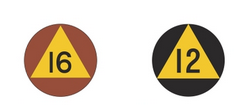Pointing and calling
Principle
Pointing and calling is a method in occupational safety for avoiding mistakes by pointing at important indicators and verbally calling out their status. It is particularly common on Japanese railways, where it is referred to as shisa kanko (指差喚呼), shisa kakunin kanko (指差確認喚呼) or yubisashi koshō (指差呼称). Gesturing at and verbalizing these indicators helps with focus.
Pointing and calling requires co-action and co-reaction among the operator's brain, eyes, hands, mouth, and ears.
Signals validation
One of the elements where "pointing and calling" is used is for signal validation (in the case where we are not in ATC/ATACS). This is done when the train leaves or when we encounter the following sign:
When you encounter this sign, you must validate, via "pointing and calling", the next visible signal. This sign may contain an indicator specifying the nature of the next signal:
- Number : block signal (heisoku / 閉塞)
- 出 : starting signal (shuppatsu / 出発)
- 場 : home signal (jōnai / 場内)
- 中 : repeating signal (chūkei / 中継)
- 遠 : distance signal (enpō / 遠方)
When validating, you typically have to say the type of signal followed by the status of the signal (in addition to pointing it). And in the case of a block signal, you must also specify the block number.
Here is the Japanese pronunciation of the different signal statuses:
- Clear signal (green) : shinkō / 進行
- Reduced speed signal (yellow/green) : gensoku / 抑速
- Caution signal (yellow) : chūi / 注意
- Speed restriction signal (yellow/yellow) : keikai / 警戒
- Stop signal (red) : teishi / 停止
Which gives, for example:
- Start with green signal : Shuppatsu shinkō / 出発進行 / Proceeding departure
- Block N° 2 with yellow signal : Dai ni heisoku chūi / 第二閉塞注意 / Caution block N° 2
- Home with yellow/yellow signal : jōnai keikai / 場内警戒 / Speed restriction on home
Other validations
In addition to signal validation, there are other elements to validate at various times. I'll just detail the main moments.
Just before departure
- Confirm door closing light: Lit (Tentō / 点灯)
- Confirm departure signal: Proceeding departure (if green) (Shuppatsu shinkō / 出発進行)
- If ATC/ATACS, confirm ATC signal on console (Shingō shinkō / 信号進行)
- Confirm watch time: Depart <station name> at <hour>, on time. (<station name> eki hassha <hour>bu chōdo, jikoku yoshi / <station name>駅発車<hour>分ちょうど、時刻よし)
Once validated, the train can start.
Arriving at a station with a stop
Do this when the home signal is visible (or, failing that, before the stop signal).
- Confirm arrival station (point to timetable or monitoring screen): Stop at <station name> (<station name> eki teisha / <station name>駅停車)
- If there are several tracks, also specify the track no. (<n°> ban / <n°>番)
Stop
- Validate BC pressure : 200 OK (200よし)
- Validate opening door closing indicator : Off (Metsu / 滅)
- Validate watch time: On time / 15s late / 7s early (Teiji / 定時 - 15 byō en / 15秒延 - 7 byō sōchaku / 7秒早着)
- Validate track, if multiple arrival/departure tracks (point to timetable or monitoring screen) : Track control. <station name>, track <n°> (Unten senro kakunin. <station name> eki <n°> ban. / 運転線路確認。<station name>駅<n°>番。)
Passing a station without stopping
- Confirm passing station (point to timetable or monitoring screen): Passing <station name> (<name> eki tsūka / <name>駅通過)
Passing a speed limit sign (end of)
- For a speed limit: Limitation, <speed> (Seigen, <speed> / 制限, <speed>)
- For the end of a speed limit (once the tail of the train has passed the sign): Limitation ended (Seigen, kaijo / 制限、解除)
Other examples and additional information are available on suzu's guide : https://steamcommunity.com/sharedfiles/filedetails/?id=3098325611

